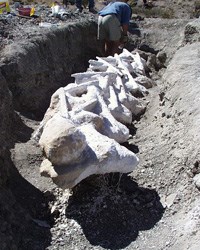
NPS Photo/Big Bend National Park Alamosaurus belongs to the group of dinosaurs named Sauropods—large herbivores with extremely long necks and tails. Alamosaurus is the only known sauropod in North America from this time period (Upper Cretaceous). Alamosaurus was named after Ojo Alamo (Cottonwood Spring) in New Mexico, where the first specimens were found early in 1922. Other Alamosaurus fossils have been found in Utah, Wyoming, and the Big Bend region of Texas. Adults were probably about 70 feet long. All North American sauropods died out about 105 million years ago. Then, after a 35–40 million year gap, Alamosaurus appeared in North America about 70 million years ago. (All dinosaurs became extinct about 65 million years ago). Some scientists believe that Alamosaurus migrated into North America from South America after the two continents were joined together by the Isthmus of Panama. This view is supported by the fact that Alamosaurus belongs to the titanosaurid family of sauropods, and titanosaurids were common in South America during the Cretaceous time period.
Big Bend's AlamosaurusIn 1999, Dana Biasetti, a graduate student from the University of Texas at Dallas, discovered giant dinosaur bones protruding from a dry hillside in the Javelina Formation of Big Bend National Park. Upon careful excavation, this hillside yielded partial pelvic bones and ten articulated cervical vertebrae of an adult Alamosaurus. The Big Bend alamosaurus appears to have been a massive individual, measuring in at 100 feet in length and probably weighing over 50 tons. Due to their extreme size and the remote location of the fossil site, excavation and removal of these giant bones by hand was nearly impossible. As a result, Big Bend National Park issued a special permit to the excavation team to remove the fossil by helicopter. In 2001, UT Dallas, now teamed with the Dallas Museum of Natural History, made history with Big Bend's first ever "dinosaur airlift." The Alamosaurus fossil was transported on a flatbed truck to the Dallas Museum of Natural History. The specimen remains the property of the National Park Service, but is loaned to the researchers so that it can be properly prepared and studied at the spacious museum. When the study is complete, the fossil or a replica will be returned to Big Bend National Park for display. |
Last updated: April 27, 2020
